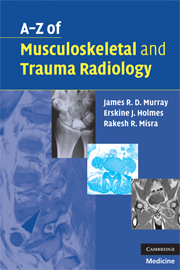Book contents
- Frontmatter
- Contents
- Acknowledgements
- Preface
- List of abbreviations
- Section I Musculoskeletal radiology
- Section II Trauma radiology
- ATLS – Advanced Trauma Life Support
- Acetabular fractures
- Aortic rupture
- Cervical spine injury
- Flail chest
- Haemothorax
- Open fractures
- Pelvic fracture
- Peri-physeal injury
- Pneumothorax
- Rib/sternal fracture
- Skull fracture
- Thoraco-lumbar spine fractures
- Acromioclavicular joint injury
- Carpal dislocation and instability
- Clavicular fractures
- Elbow injuries and distal humeral fractures
- Hand injuries – general principles
- Hand injuries – specific examples
- Thumb metacarpal fractures
- Humerus fracture – proximal fractures
- Humerus fracture – shaft fractures
- Humerus fracture – supracondylar fractures – paediatric
- Radius fracture – head of radius fractures
- Radius fracture – shaft fractures
- Galeazzi fracture dislocation
- Radius fracture – distal radial fractures
- Related wrist fractures
- Scaphoid fracture
- Scapular fracture
- Shoulder dislocation
- Ulna fracture – proximal and olecranon fractures
- Ulna fracture – shaft fractures
- Monteggia fracture dislocation
- Accessory ossicles of the foot
- Ankle fractures
- Bone bruising
- Calcaneal (Os calcis) fractures
- Femoral neck fracture
- Femoral shaft fracture
- Femoral supracondylar fracture
- Hip dislocation – traumatic
- Knee soft-tissue injury
- Metatarsal fractures – commonly fifth MT base
- Patella fracture
- Tibial-plateau fracture
- Tibial-shaft fractures
- Tibial-plafond (Pilon) fractures
- Talus fractures/dislocations
Radius fracture – shaft fractures
from Section II - Trauma radiology
Published online by Cambridge University Press: 22 August 2009
- Frontmatter
- Contents
- Acknowledgements
- Preface
- List of abbreviations
- Section I Musculoskeletal radiology
- Section II Trauma radiology
- ATLS – Advanced Trauma Life Support
- Acetabular fractures
- Aortic rupture
- Cervical spine injury
- Flail chest
- Haemothorax
- Open fractures
- Pelvic fracture
- Peri-physeal injury
- Pneumothorax
- Rib/sternal fracture
- Skull fracture
- Thoraco-lumbar spine fractures
- Acromioclavicular joint injury
- Carpal dislocation and instability
- Clavicular fractures
- Elbow injuries and distal humeral fractures
- Hand injuries – general principles
- Hand injuries – specific examples
- Thumb metacarpal fractures
- Humerus fracture – proximal fractures
- Humerus fracture – shaft fractures
- Humerus fracture – supracondylar fractures – paediatric
- Radius fracture – head of radius fractures
- Radius fracture – shaft fractures
- Galeazzi fracture dislocation
- Radius fracture – distal radial fractures
- Related wrist fractures
- Scaphoid fracture
- Scapular fracture
- Shoulder dislocation
- Ulna fracture – proximal and olecranon fractures
- Ulna fracture – shaft fractures
- Monteggia fracture dislocation
- Accessory ossicles of the foot
- Ankle fractures
- Bone bruising
- Calcaneal (Os calcis) fractures
- Femoral neck fracture
- Femoral shaft fracture
- Femoral supracondylar fracture
- Hip dislocation – traumatic
- Knee soft-tissue injury
- Metatarsal fractures – commonly fifth MT base
- Patella fracture
- Tibial-plateau fracture
- Tibial-shaft fractures
- Tibial-plafond (Pilon) fractures
- Talus fractures/dislocations
Summary
Characteristics
Fall on out-stretched hand or direct trauma.
May be in isolation or with associated ulna fracture, or with dislocation of the distal radio-ulnar joint – Galeazzi pattern – see below.
Seen in both the adult and paediatric population.
Clinical features
Pain, deformity, swelling, bruising and crepitus.
Possible associated distal (Galeazzi) or proximal joint subluxation.
Neurovascular injury possible.
Compartment syndrome possible – look at passive stretching of dorsal and volar compartments.
Radiological features
AP and lateral views – including the joints above and below should suffice.
Displaced fractures have > 10° angulation (risking future pronation/supination), or > 50% displacement.
Management
ABCs, analgesia, immobilisation with above-elbow backslab initially.
Undisplaced fractures are treated non-operatively with closure of the backslab at approximately 7 days when the swelling has subsided, and changing to short arm cast at approximately 4 weeks until union.
Displaced fractures require ORIF with a compression plate.
In children MUA ± flexible ‘Nancy’ intramedullary nails should be performed.
- Type
- Chapter
- Information
- A-Z of Musculoskeletal and Trauma Radiology , pp. 262 - 263Publisher: Cambridge University PressPrint publication year: 2008



